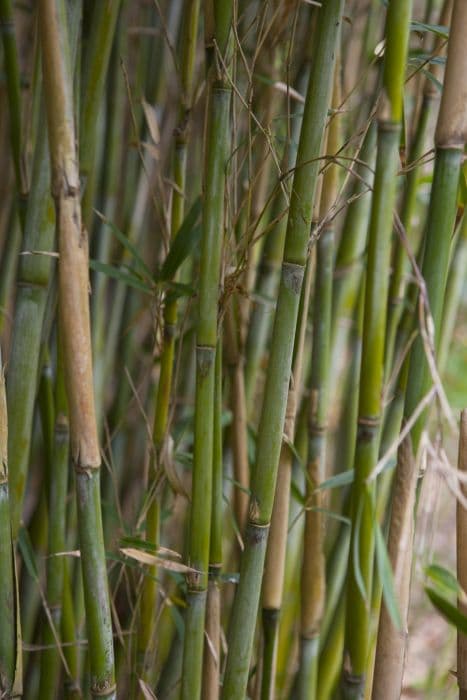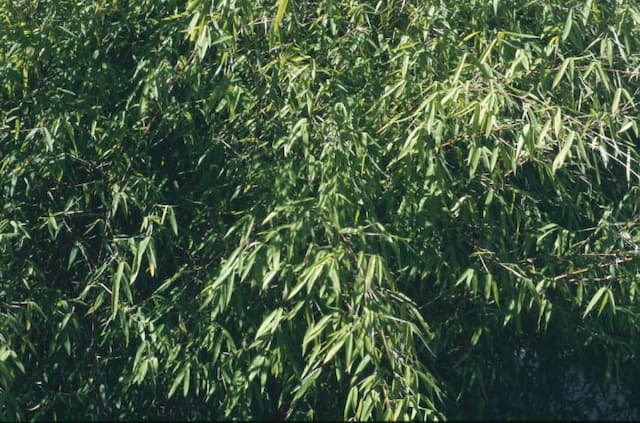Pampas Grass Cortaderia selloana

ABOUT
The plant commonly known as pampas grass is a striking and elegant ornamental grass that is well-known for its large, fluffy flower plumes. These impressive plumes emerge above the tufted, clump-forming base and are usually silvery white, though they can also be found in soft shades of pink or purple. The flowers provide a feathery, delicate texture that sways gracefully in the breeze. Pampas grass has long, narrow, and arching leaves that form dense tussocks. The foliage is a bright green to bluish-green color and can be quite sharp to the touch, with edges that resemble serrated blades. During the growing season, these leaves create a lush, fountain-like mound that serves as a stunning backdrop for the showy flower spikes. The plant blooms in the late summer and into the fall, and the plumes it produces can be so dense with flowers that they almost resemble a soft, bristly brush. After the blooming period, the plumes will often persist, providing visual interest throughout the winter months. As they age, the flowers may turn from their original color to a tawny hue, which can add a different aesthetic quality to the garden landscape. Pampas grass is a hardy plant that continues to offer a striking visual element even after the growing season, making it a popular choice for creating focal points in gardens, or for adding structure to large open spaces. Its feathery plumes are also commonly used as cut flowers or in dried floral arrangements, thanks to their enduring beauty.
About this plant
 Names
NamesFamily
Poaceae
Synonyms
Pampas Grass, Andean Pampas Grass, Argentine Pampas Grass, Uruguayan Pampas Grass
Common names
Gynerium argenteum, Cortaderia argentea, Cortaderia dioica, Arundo selloana.
 Characteristics
CharacteristicsLife cycle
Perennials
Foliage type
Evergreen
Color of leaves
Green
Flower color
White
Height
6-10 feet (1.8-3 meters)
Spread
6-8 feet (1.8-2.4 meters)
Plant type
Grass
Hardiness zones
8
Native area
South America
Benefits
 General Benefits
General Benefits- Ornamental Value: Cortaderia selloana, commonly known as pampas grass, is widely appreciated for its large, fluffy plumes and ability to add visual interest to landscapes.
- Erosion Control: The dense root system of pampas grass helps stabilize soil and prevent erosion on slopes or in areas prone to wind and water wear.
- Privacy Screen: With its tall and fast-growing nature, pampas grass can quickly form a natural privacy screen or hedge, providing seclusion for gardens and outdoor spaces.
- Wildlife Habitat: The dense foliage and seed plumes of pampas grass provide shelter and food for birds and other wildlife.
- Drought Tolerance: Pampas grass is highly resilient to drought conditions, making it suitable for xeriscaping and low-water landscapes.
- Windbreak: The plant can act as a windbreak, protecting smaller plants and reducing wind speed in exposed areas.
- Seasonal Interest: Pampas grass offers year-round visual interest with its evergreen foliage and long-lasting plumes that remain attractive even during the winter months.
- Low Maintenance: Once established, pampas grass requires minimal care, making it a low-maintenance option for gardens and public spaces.
- Versatile Landscaping: Pampas grass can be used in a variety of landscape designs, from formal to naturalistic settings.
- Sound Buffering: The dense growth of pampas grass can help to absorb and reduce noise pollution in urban and suburban environments.
 Medical Properties
Medical PropertiesThis plant is not used for medical purposes.
 Air-purifying Qualities
Air-purifying QualitiesThis plant is not specifically known for air purifying qualities.
 Other Uses
Other Uses- Pampas grass is often used in dried flower arrangements, adding an element of volume and drama due to its tall plumes.
- Pampas grass can be employed as a privacy screen in gardens as it grows quickly and thickly, providing an effective barrier against noise and unwanted views.
- The dense growth of pampas grass makes it suitable for erosion control on slopes and banks, helping to stabilize the soil and prevent landslides.
- Pampas grass is sometimes used in crafting for making wreaths, dream catchers, and other decorative items thanks to its sturdy and attractive plumes.
- In landscape design, pampas grass can be utilized to create a focal point, especially in large gardens, due to its size and unique appearance.
- The plant's tall and strong stalks have been used in some cultures to make paper and as a raw material in the production of bioenergy.
- Gardeners often use pampas grass to add texture and contrast in perennial beds and borders, exploiting the plant's architectural properties to enhance visual interest.
- Pampas grass can be incorporated into fall displays, complementing pumpkins and other autumnal decor with its feathery plumes that catch the light.
- Some fashion designers use the pampas grass plumes as accessories or embellishments in haute couture, especially in runway shows for dramatic effect.
- Due to its invasive nature in certain climates, pampas grass may sometimes be used in initiatives aimed at reclaiming disturbed lands and preventing the spread of more aggressive invasive plant species.
Interesting Facts
 Feng Shui
Feng ShuiPampas grass is not used in Feng Shui practice.
 Zodiac Sign Compitability
Zodiac Sign CompitabilityPampas grass is not used in astrology practice.
 Plant Symbolism
Plant Symbolism- Invincibility: Commonly known as Pampas Grass, Cortaderia selloana is a robust plant that can thrive in various conditions, symbolizing strength and the ability to withstand challenges.
- Beauty and Softness: With its feathery plumes and elegant stature, Pampas Grass is often associated with aesthetic beauty and softness, contrasting its actual hardiness.
- Privacy: Pampas Grass is frequently used in landscaping to create natural barriers, making it a symbol of privacy and seclusion.
- Growth and Fertility: The rapid and lush growth of Pampas Grass can symbolize fertility and the abundance of life.
 Water
WaterFor Pampas grass (Cortaderia selloana), it's essential to maintain a consistent watering schedule during its growing season in the spring and summer. Water it deeply once a week, providing about 1 to 2 gallons per plant depending on soil conditions and climate. Pampas grass prefers a thorough watering that reaches the deep roots rather than frequent shallow waterings. During periods of drought or extreme heat, increase the frequency to twice a week. In the fall and winter, reduce the amount of water as the plant goes dormant, and heavier rainfall typically supplements its needs.
 Light
LightPampas grass thrives in areas that receive full sun for at least six hours a day. The best spot for this plant is an open area without shade from buildings or trees, as ample sunlight is crucial for its growth and the development of its distinctive plumes. If the grass is planted in too much shade, it may not bloom properly and can become sparse.
 Temperature
TemperaturePampas grass prefers temperate conditions and can tolerate a wide range of temperatures. It can survive in conditions as low as 20 degrees Fahrenheit and up to around 100 degrees Fahrenheit. The ideal temperature range for Pampas grass to thrive is between 70 and 90 degrees Fahrenheit. However, it can endure slight dips and spikes outside of this range without significant damage.
 Pruning
PruningPampas grass should be pruned to remove old foliage, encourage new growth, and maintain its shape. The best time to prune is in late winter or early spring before the new growth starts. Cut the grass back to about 1 to 2 feet above the ground. Pruning is typically required once a year, but if the plant becomes too large or messy, additional shaping can be done throughout the growing season.
 Cleaning
CleaningAs needed
 Soil
SoilPampas Grass requires a well-draining soil mix with a pH range of 6.1 to 7.5 for optimal growth. A mix of garden soil, peat, and coarse sand in equal parts can provide the right structure and nutrients. Regular fertilization will enhance its lush foliage.
 Repotting
RepottingPampas Grass doesn't typically require frequent repotting due to its size; however, it may be repotted once it outgrows its current location or when division is performed for propagation, which is usually done every 2 to 3 years.
 Humidity & Misting
Humidity & MistingPampas Grass is tolerant of a wide range of humidity conditions and does not require any special humidity requirements. It thrives in both dry and humid climates as it is a very adaptable plant.
 Suitable locations
Suitable locationsIndoor
Ensure full sun, well-draining soil, and ample space for growth.
Outdoor
Plant in sunny area, provide ample space, and water deeply.
Hardiness zone
7-11 USDA
 Life cycle
Life cyclePampas grass (Cortaderia selloana) starts its life as a seed, which when sown, germinates in warm soil with good sunlight exposure. The seedling establishes a deep root system and begins to grow long, narrow leaves in a dense clump. As the plant matures, generally in late summer to early fall, it sends up tall flower plumes that can be several feet high. These plumes are either male or female, as pampas grass is dioecious, with separate male and female plants. After pollination, typically by wind, the female plants produce seeds that are dispersed by wind and animals. Pampas grass is a perennial, so after the growing season, it becomes dormant in the winter, then regrows from its base the following spring, continuing its cycle for several years.
 Propogation
PropogationPropogation time
Spring-Early Summer
Propogation: Pampas grass, scientifically known as Cortaderia selloana, is typically propagated through division, which is the most popular method. This involves splitting the large, dense clumps that the plant forms into smaller sections. The ideal time for propagating pampas grass by division is in the late winter or early spring, when the plant is not actively growing. To effectively divide pampas grass, a sharp spade or even a saw may be required due to the toughness of the root ball. It's important to replant the divisions promptly and water them thoroughly to ensure they establish in their new location. Each division should have a substantial piece of the root system and several growing points to foster successful regrowth.









